One name that takes up more newspaper columns than anyone else in my Calder Valley family. It that of Stansfield Gibson. Like his father Joshua he was a butcher and innkeeper like his father, but also like his father he took his own life. But that life had been a colourful one and he had certainly packed more than most into those 78 years. He married five times, fathered seven children, was accused of child molestation, purchased a chapel and was the proud owner of a prize winning pony.
It can’t have been an easy start in life for Stansfield, the 8th out of 9 children. His mother, Sally, whose maiden name he was name after, died when he was fifteen and his father, Joshua, hanged himself three years later. Just six months after this tragedy on November 2, 1858 Stansfield, then aged 19, married Harriet Walker at St James’s church in Hebden Bridge. I sometimes provide the music there for services and I often think about the significant events that took place in the building as I’m seated at the organ.
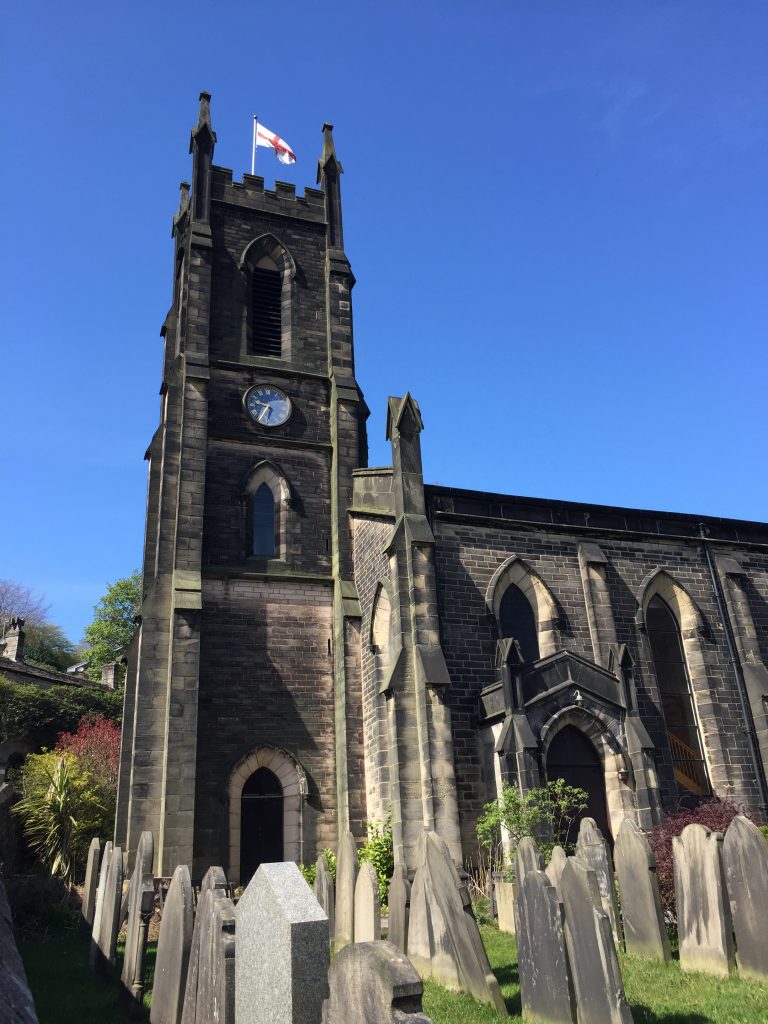
Their marriage was performed by Sutcliffe Sowden. Rev Sutcliffe Sowden had been a friend of Arthur Bell Nichols, Charlotte Bronte’s husband, and had presided at Arthur and Charlotte’s wedding and at Charlotte’s funeral less than a year later. Rev Sutcliffe Sowden had baptized Stansfield, then aged 17 and his brother Richard aged 15 on the same day June 24, 1855 at St James’s, less than three months after he had conducted Charlotte’s funeral service. Stansfield was to follow in his father’s and grandfather’s footsteps being first a butcher and later a butcher-cum-innkeeper, a common dual occupation providing a ready source of food for guests at the inn. This necessitated a slaughter house being situated close to the inn, and in Joshua’s case this was the scene of his tragic demise. In Stansfield’s case it was the presence of his slaughter house that was to caused conflict with several of his neighbours. After their marriage Stansfield and Harriet continued living on Bridge Lanes where he had grown up. Its main street was known as High Street because of its elevation, not for its commercial prominence. When the entire development was demolished in the 1960s the foundations of those buildings were just left in place leaving an ugly scar at the west entrance to the town but through voluntary community efforts a landscaping project was undertaken and I can now stroll through this place along a reasonable footpath bordered by wildflowers. In fact, I saw my first bluebell of 2020 in this shaded spot.

By 1870 the family had moved to Meadow Bottom, close to the railway in Todmorden and it was here that Harriet died of tuberculosis on July 28, 1870 aged just 33 years of age. She was buried at Heptonstall church. With the death of his wife Stansfield became the sole parent of six daughters, the eldest being Louisa Ann who was just eleven years old.
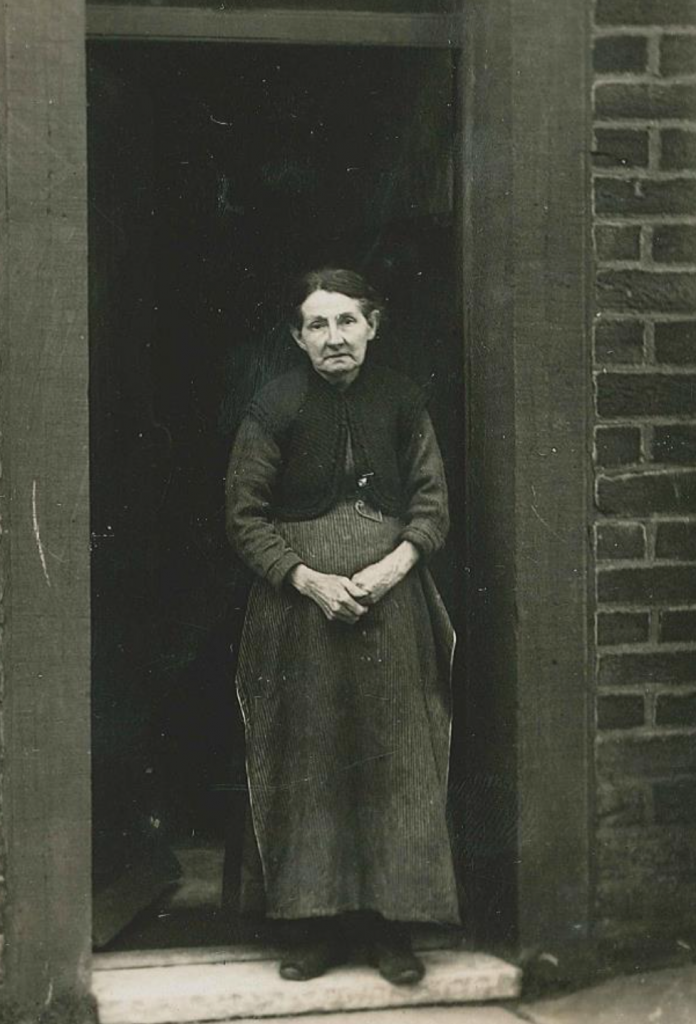
On the census of 1871 the word scholar after her name has been crossed out and next to it is written and ‘half time Fustian Operator,’ meaning Louisa went to school part time, and worked in the fustian factory part time. No wonder so many children fell asleep at work and were injured by machinery. It was imperative that Stansfield find a new wife and stepmother for the girls and so just 9 months after Harriet died he married a widow, Susannah Greenwood, whose maiden name was also Stansfield, just to confuse matters! The couple were married at St Paul’s church, Cross Stone, in the township of Stansfield (!) on April 17, 1871. The church had been rebuilt in 1833, with money from the so-called Million pound act. With the increase in population during the industrial revolution two acts of parliament in 1818 and 1824 had funded the building of churches to cater for the religious needs of the people. The rebuilding of Cross Stone church was testament to the growth and success of Todmorden’s textile industry in the first half of the nineteenth century. But there had been a church on the site since 1450 when it was erected as a chapel of ease for Heptonstall church. As such it provided a church more readily accessible for parishoners living a long distance from the church. But this ‘chapel of ease’ like its mother church lies atop a very steep hill standing 300 ft above the valley floor. Today a road leading towards it is name Phoenix Street which I’ve always thought as amusing, especially since that street peters out as if it’s found the climb up to the church so steep that it can’t make itself rise from the ashes. How on earth coffins or grieving mourners, many of them elderly, reached the cemetery on snowy days in winter, I can’t imagine. I decided that the church would be a good starting point for my day with Stansfield but I decided to approach it from above walking first along the hilltops from the bus terminus at Blackshaw Head. It’s a wonderful walk – in fine weather that is – with amazing views over the Calder valley. Many days when the sky above the valley is dull, pewter-bellied clouds seem to hang suspended barely above my head, pushing me down, lowering my spirits. If I can persuade myself to venture out I climb out of the valley, by foot or bus and suddenly I’m above those clouds, in a world of ever-changing light, with glorious vistas spread out before me, making me feel like as if I’m getting my own private viewing of the beauty stretched out before me. As I have become more familiar with the area I can now pick out many more districts and buildings associated with my family. The wonderfully named villages of Lumbutts and Mankinholes are perched on the shelf on the opposite side of the valley.
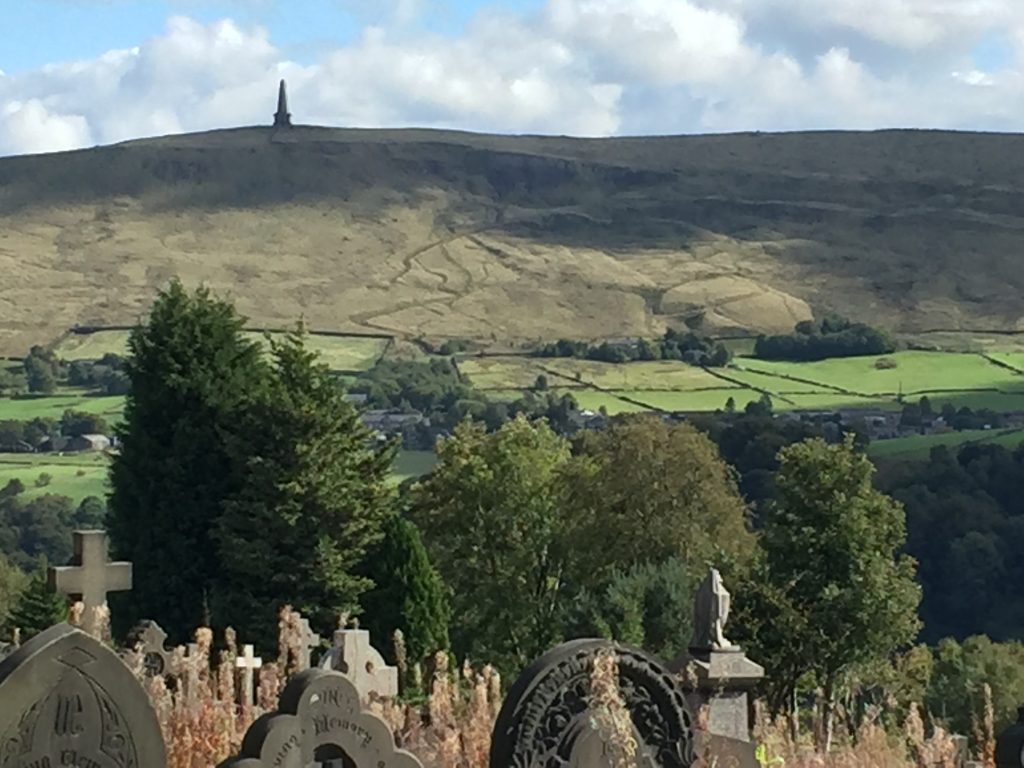
So steep is the hillside here at Cross Stone that the roof of the church is on a level with the road. It’s an unlikely spot for another Bronte connection but there is one. In 1829, a certain John Fennel was vicar here but before he got the Cross Stone appointment, he was the first head teacher in 1812, at Woodhouse Grove Wesleyan School from where he was dismissed for spending too much time arranging picnics for his niece Maria Branwell, who was to become the wife of Patrick Bronte and mother to Charlotte. When Charlotte visited her uncle John Fennel in 1829 at Cross Stone he was living in the old parsonage house in the chapel grounds. She wrote to her “dear papa” that the house was “nearly in ruins.” Six years before her stay Fennel had collected subscriptions amounting to over £200 in order to repair the parsonage. Either the repairs were not carried out or they were not successful if Charlotte’s letter reflected the situation correctly .

Ten years after Stansfield and Susannah were married at Cross Stone the church itself closed for repairs, but then in 1894 dry rot set in and although it continued to function for some time it has now closed permanently and converted into a house. As I approached it a large For Sale sign dominated the site but on closer observation I realized that it was the adjacent building, not the church, that was for sale. This large two storey building has its own interesting history. Built as a school in the early 1800s it provided free schooling for six poor children in the town and the teacher’s income was provided by the parents of the 30-40 students who paid for tuition in reading and writing. A William Greenwood says that he held school on Sunday mornings and up to twenty children attended. They were charged one penny a week. Quills cost half a penny, copy books two pennies, a reading essay was sixpence and “rithmetic” was one shilling and eight pence. While the far right hand side of the house was the home of the schoolmaster the bottom storey served as the jail, a daily reminder of the fate awaiting those exhibiting unruly behaviour if ever there was one. Today wrought iron railings preventing the unwary pedestrian from falling into the house’s yard had been freshly painted judging by the drip mats beneath them, and were proudly sporting their new shiny black paintwork. I left the site of Stansfield and Harriet’s wedding and walked down the steep hill into Todmorden town centre to see if I could visit other places connected with Stansfield’s story. He moved his new family to Roomfield Lane, now the main Halifax Road in the centre of Todmorden town where he pursued his occupation of butcher. An article in the local paper on June 26, 1874 gives a momentary glimpse into everyday life for the people of Todmorden. “On Saturday forenoon last, as Marshall Sutcliffe was driving a galloway at Pavement, Todmorden, in a small butcher’s cart belonging to Stansfield Gibson, the galloway began to kick. There were in the trap two females, whose safety, with that of the driver, was a matter of concern to numerous spectators. The galloway, still kicking and plunging, got its head against Mr. W. Uttley ‘s butcher’s shop. It was then laid hold of by one or more persons, but continued kicking and plunging. The trap was upset, one of the young women slid off the side of the conveyance, and the other was taken from it by bystanders. After a sharp tussle with the pony to bring it to a standstill, it was finally subdued. The body of the trap kicked off, and the harness rent in various parts. Behind Roomfield Lane is the impressive structure of Todmorden market hall built in only eight months in 1879 and situated close to Stansfield’s shop. It’s one of my favourite markets but sadly today in the lockdown the marketplace was as empty as a ghost town.

But lovely as the Victorian market was, the living conditions of the surrounding residents were appalling as was borne out by the report of the sanitary committee on August 11, 1876: “If the following complaints are not rectified the ‘inspector of nuisances’ will take legal proceedings against the following parties: I would remind you that Miss Sutcliffe has a drain made up on her property in Roomfield Lane, and the house slops and refuse water are flowing on the street. At the same place, Stansfield Gibson, butcher, has a very offensive midden on the side of the street leading up to the back houses, and he is also in the habit of slaughtering sheep and lambs in a place behind his house, which has not been registered as a slaughterhouse. What a shambles! In fact the term shambles originally referred to a street or area in a city where the butchers lived, and has come to mean chaos or mess from the highly unsanitary conditions of waste disposal used there.
Judging by several reports in the local newspaper reports Stansfield was not an easy man to get along with, both in his professional life and also in his private life. As a butcher Stansfield would have raised the animals that he sold as meat in the shop and he farmed his own sheep and poultry. In January 1878 Stansfield was taken to court by the farmer of an adjacent field who claimed that Stansfield’s sheep had damaged his land. Two years later Stansfield encountered more problems caused by his business. In a column in the local newspaper entitled ‘Rival Poultry Keepers’ the reporter described an incident in which Stansfield and his 18 year old daughter Sarah Ann were summoned on a charge of aggravated defamation against a neighbour, one James Crowther. In court Crowther said that “about three months since he bought some poultry, and since that time he had had nothing but bother with the defendant, who had been continually buying fresh cocks to kill his. Stansfield said he would have another cock; Crowther replied, Thou can get as many cocks as thou likes, but keep that cayenne pepper off. ” Sarah Ann reportedly called James’s wife “a nasty b___” and added that she was continually abused by the whole family and on one occasion sent their cousin Oliver Stansfield to abuse her. She was almost afraid to stay in the house by herself. One day Mrs Crowther was standing at the shop door serving? the hens. Stansfield’s cock came and began to eat along with the hens. She shooed it off and Stansfield said “Throw a stone at it and I’ll take you to Todmorden”- meaning the court which was held in the town hall, a fine building standing mere stone’s throw from the scene of the altercation. When Mr Crowther appeared on the scene Stansfield challenged him to come out and he would give him a good hiding. Sarah Ann and Stansfield were fined £5, bound over to keep the peace for 6 months and ordered to pay the costs-15s. Perhaps Stansfield did not keep the peace as instructed or maybe the neighbours had had enough of the Gibson family for his landlady gave him notice to vacate the shop and house. Only two years later in the Spring of 1882 Stansfield along with three other butchers from Todmorden was fined under the cattle diseases act 10s for moving bullocks without a license. Animal identification and traceability was and still is important for disease control and public confidence in farm produce and a license is still required in Calderdale if you want to move even just one animal. But it wasn’t just issues in his business ventures that made newspaper headlines. There were family problems too. In 1883 Stansfield’s daughter, Sarah Jane, then aged 21 charged Bentley Fielden with the paternity of her daughter, born on Christmas day, 1882. Bentley denied being the father of the child and said that he had stopped seeing Sarah Jane because she had asked him to marry her. However the court ruled that Bentley should pay 3 shillings weekly for the upkeep of the child and ten shillings for the cost of the midwife who had attended baby Harriet’s birth. An interesting follow up to the story is that two years later Sarah Jane gave birth to another daughter, Alberta, and three years after that Sarah Jane married , yes, Bentley Fielden at Heptonstall church! But a happy marriage it was not. In 1897 Bentley was convicted of aggravated assault on his wife and a separation order was issued. Sarah Jane and Harriet moved in with her father, Stansfield, having received not one penny in support from Bentley during that time. After an incident when Bentley showed up at Stansfield’s house just as Stansfield had arrived bringing in a duck for their Sunday dinner Bentley seized Stansfield, hit him several times about the face and neck with both fists. Sarah Jane and her aunt, who was acting as Stansfield’s housekeeper managed to restrain Bentley while Stansfield ran off to find a policeman. In court Bentley accused Stansfield of having taken Sarah Jane to those dens of iniquity, Blackpool and Scarborough and slept with a child thirteen years of age. Stansfield denied this and no further action against Stansfield was taken. Bentley, on the other hand, was sentenced to one month in prison with hard labour.
In the spring of 1885 Stansfield decided to follow in his family’s footsteps and became landlord of the New Inn just across the main road from his butcher’s shop. Stansfield’s children Emily and Herbert assisted with work in the pub and it was from his work there that Herbert learned the job of being a landlord, a profession he was ultimately to take up himself. The New Inn that Stansfield had taken over in 1885 in a busy part of Todmorden was a 3 storey property almost next door to two more inns, the Rope and Anchor and the York Hotel but the area was full of mills and foundries, all with workforces that needed a pint after work. Indeed, within 250 yards more than one hundred houses had been erected during the previous ten years for the mill workers and there were at least 500 people living there This was a time when the word ‘inn’ actually meant that it had rooms for rent and under a previous landlord by the wonderful name of Robert Crook the business prospered and around twenty lodgers lived there. An added bonus for both residents and visitors was the presence of a resident pianist, an Irish girl named Dina who provided music for the nightly sing songs. The site of the New Inn is now the car park at Todmorden health centre and as I stood there 136 years to the day that Stansfield took over the pub I imagined the faint sound of a piano being played – Dina was on top form. Long after Dina’s music had faded into the mists of time on Friday the 13th October 1972, the building collapsed and fell down.
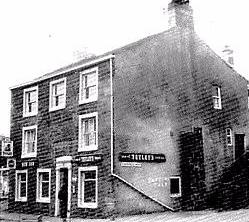
I’m sure the New Inn would have done a roaring trade on the day of the 1889 annual Todmorden Floral and Horticultural Show and Athletic Festival, a show still in existence. With prizes awarded for everything from ‘Two cauliflowers and 2 cabbages’, to ‘12 white gooseberries’ and ‘2 cock chickens’ the festival was a big attraction. For the 2 mile race for ponies six competitors turned up. Luke Greenwood’s pony led for the first mile, but was then passed by R. Cropper’s “Daisy” and Stansfield Gibson’s “Polly.” Gibson’s Polly got behind but at the mile and a half had regained second place. Stansfield took home with him a gentleman’s travelling bag worth £1 6 shillings as runner up. I wonder if Polly had been the pony who had thrown Herbert from her back just three years before.
Stansfield’s wife Susannah died a couple of days after Christmas in 1894 and was buried on New Year’s Eve high above Todmorden at Cross Stone church, the scene of her wedding to Stansfield. I wonder what the weather was like as the cortege made its way up the steep hill. Less than a year later, in the summer of 1895 Stansfield married another widow, Fanny Walters, 18 years younger than himself who had been widowed the previous year. They were married at Heptonstall church 1895 and later that year Stansfield took over the license of the Railway Hotel in Littleborough, a town on the West of the Pennines that had grown up around the industry enabled by the building of the Rochdale canal and the trans Pennine railway. Stansfield’s pub still overlooks the canal but it is now known as The Waterside, an upscale restaurant and bar.

Six years later Stansfield was widowed for the third time and soon after a notice in the local newspaper on February 8th 1901 instructed that all Stansfield’s household possessions were to be sold at auction because he was leaving the district. I find it fascinating to see Stansfield’s wordly possessions itemized and feel they need to be listed in their entirety since it gives an insight into both his standard of living and also gives us a snapshot of his day to day existence. I wonder if he could play the piano himself or if it was an instrument that others would play in the pub. I had to smile at the commode disguised as a small chest of drawers. “Dining room suite upholstered in saddle bag style including Couch, 2 easy and 6 single chairs, a noble 5ft walnut sideboard, with carved back having 3 bevelled plate-glass mirrors drawers, and cellaret complete; a brilliant toned cottage pianoforte, in walnut case, with panelled front and candelabra by Schuppinser and sons, London, oval walnut centre table; Milners’s patent fireproof safe, 26in. by 20 in by 20 in., brass curb, with fixed dogs: set of fire brasses: brass ash pan; pollard oak and brass-mounted coal vase, bamboo occasional table, tapestry bordered carpet square. 12ft. by 10ft., Axminster hearth rug, oil paintings: spirit decanters in E.P. Frame, F.P. Cruet, case of cutlery, flower vases and plaques, Chinese idol and stand; quantity of small Chinese figures and ornaments, Opera glass, glass dishes, wines and tumblers. Handsome walnut bedroom suite including 4 ft wardrobe, with centre mirrors, dressing table, with bevel plate glass mirror, washstand, with towel airer, marble top and back; and 3 upholstered chairs; stained dressing table, with mirror affixed; stained washstand, with tiled back, brass and iron Parisian bedstead, with tapestry hangings, woven wire, wool, and straw mattresses, feather beds, bolsters, and pillows, tapestry carpet square, 13ft. 4in. by 21ft 9in, toilet services, capital mahogany night commode to imitate small chest of drawers. KITCHEN: Polished birch long settle and cushions, stained square table, with deal top, Pembroke table, 3 bentwood chairs, wringing machine, wash tubs, clothes horses and dolly, dinner service, 2 copper kettles, fender and fire irons together with the usual kitchen and culinary requisites. Also a capital wicker work bath chair with cushions, etc., complete, nearly new. But why was he selling all his possessions? Less than a year after Fanny’s death he was getting married for a fourth time, to a widow named Maria Ann Winfindale. Her husband had been the landlord of The Falcon Inn in Scarborough on the coast in East Yorkshire and around 100 miles from Littleborough and so he was selling up and moving East.
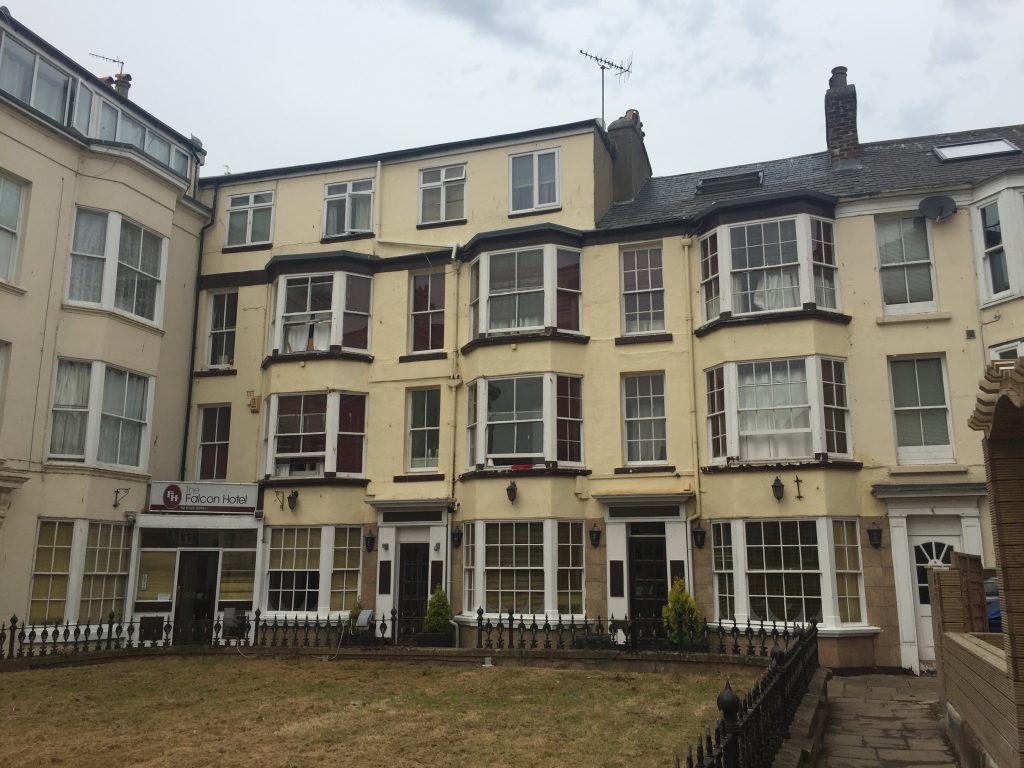
Only four years later Stansfield was widowed again. The call of West Yorkshire appears to have been strong for Stansfield moved back to the Calder Valley and I find Stansfield mentioned in the newspaper in perhaps the most unexpected of all his appearances. In June 1908 Stansfield bought a chapel! “A fairly good company assembled at the Dusty Miller Inn on the occasion of the premises formerly used as a chapel and school by the Primitive Methodists being offered by public auction. After some spirited bidding £151 was reached. And Mr 16 John Greenwood was the purchaser. Yesterday John Greenwood resold the property to Stansfield Gibson at a nice profit.’ Now whether he bought it merely as a financial investment I have been unable to ascertain and it took many hours of research both online and wandering around the streets of Mytholmroyd before I located the building – or rather, the site of the building for it no longer exists. A chapel and school had been built at Sunny Bank by the primitive Methodists in 1837 but when the congregation grew larger a New Chapel, Mount Zion, was built, which opened in 1888.
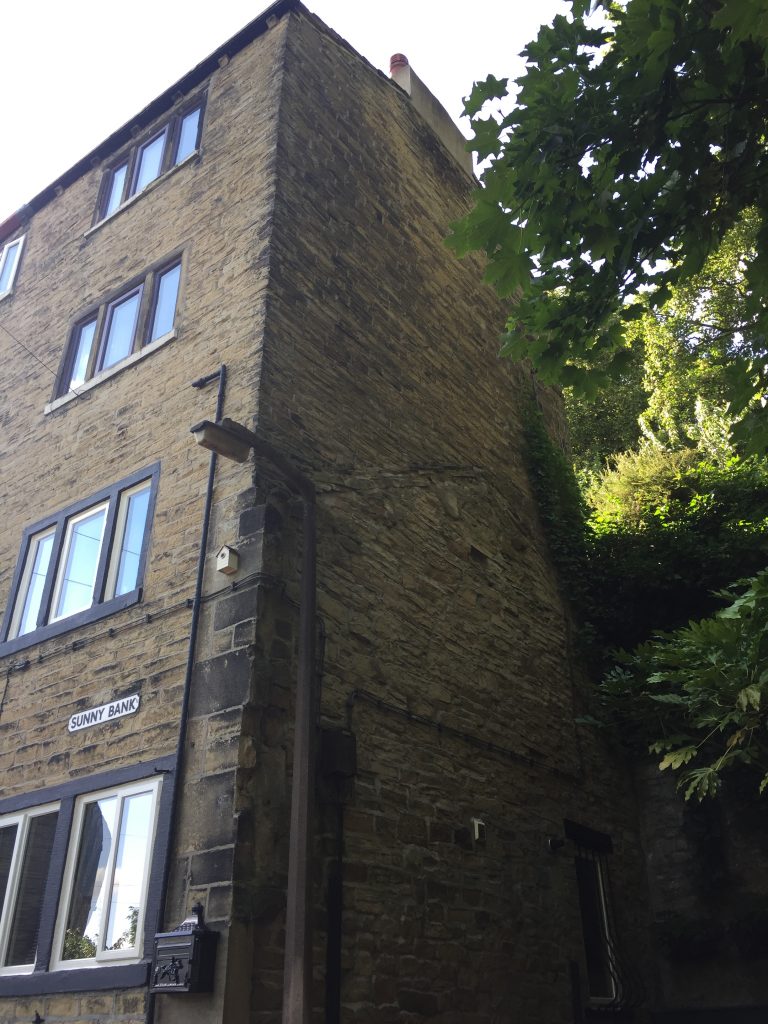
This second chapel was an enormous building almost at the bottom of Midgley Road and overshadowed the houses around it. But it was the earlier chapel that Stansfield purchased and at the end of Sunny Bank terrace there is an area of unkept grass. I clambered over a wall onto the grass. Above me I could discern the outline of a roof on the gable end of the existing terrace of cottages which would have been the chapel or school roof. I was standing inside Stansfield’s chapel. From the lack of further references to the building or Stansfield’s connection with it I presume that he purchased it as a financial investment. The following year, 1909-1910 Stansfield was living in a rented house 14 Brook Street in the centre of Todmorden. From the site of the New Inn it was only a minute’s walk to Brook Street. No houses remain on that road now just a post office , a discount store and a charity shop. But by 1911 Stansfield, now 73, was living at 1 Anchor Street, just a couple of minutes walk away. The census firmly states that he is living apart from his wife but with a housekeeper, Mary Dearden, ‘a widowed servant’ aged 69. 1 Anchor Street is the middle section of a three storey building, the front of which, facing the main road now houses Buttylicious snack bar which must have been Stansfield’s butcher’s shop, so I called in for a cup of tea to takeaway with me as I went to take vintage style photographs of the various back streets less then 8 feet wide housing a confusion of wheelie bins and recycling baskets.
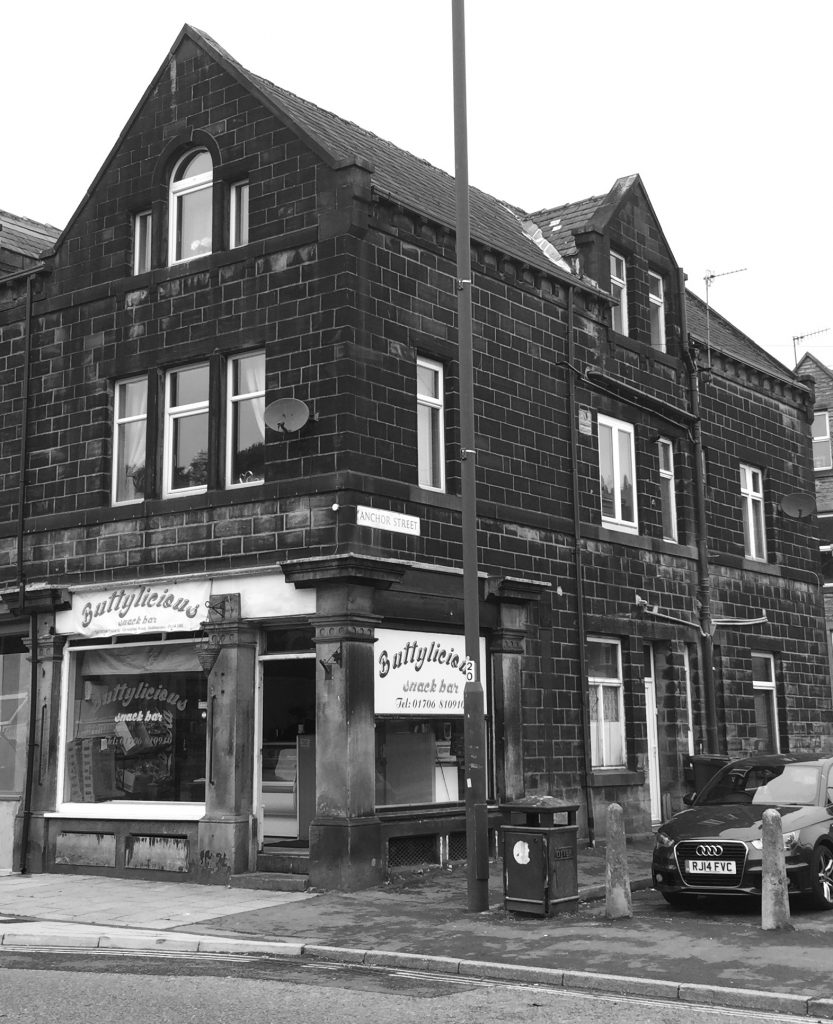
In 1914 while living at Halifax road capitalise he was entitle[d] to vote in the elections of Mytholmroyd the description of his qualifying property being Mount Zion! Five years later Stansfield decides to shut up shop for the last time and on 18 Aug 1916 the following advertisement appears in the local paper: ‘To let or sell – Butcher’s shop and house #139 Halifax Road, Todmorden; suitable for any business. Apply S. Gibson, Hebden Bridge.’ The following year Stansfield was making headlines in the newspaper again, and again for a disturbing reason. He was living at 40 Cameron Street, Burnley, with his son-in-law, a home close to the canal and in the middle of one of the long rows of terraced stone houses that characterize the town.
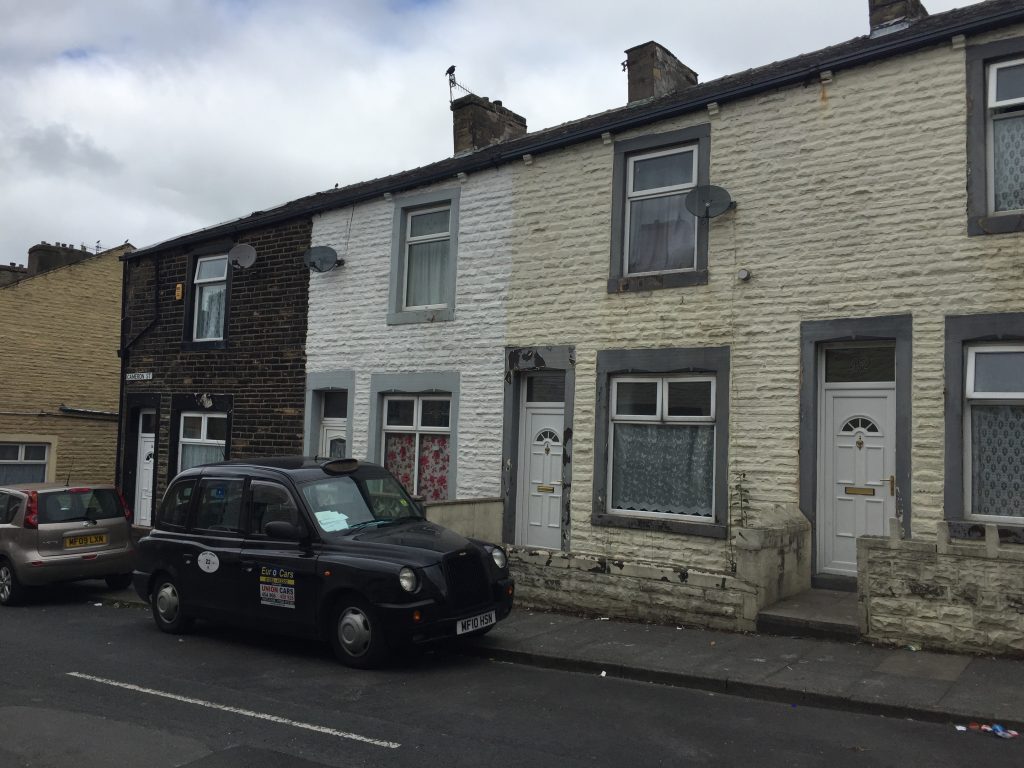
The newspaper article on 17 November, 1915 makes sad reading: ”Old Man’s Attempted Suicide. Old man, named Stansfield Gibson was charged with attempting commit suicide by cutting his throat with a table knife about 2-30 a.m. on Saturday, November 6th, 40, Cameron Street, where he lived with his son-in-law. At the time the occurrence the son-in-law heard a noise downstairs. Going down found the prisoner crouched at the bottom. He asked him what was the matter, and prisoner said: ” I have cut my throat.” The son-in-law picked him up, put him in a chair, and sent for the police. The police rendered first aid and took the man straight away to the hospital, where he had been until that morning when was discharged. Supt. Hillier said that the prisoner had become depressed through failing eyesight, and his home had been broken up at Todmorden about three months ago. The case was dismissed on the prisoner promising not to attempt anything of the kind again. Two years later Stansfield passed away. He died at 112 Bridge Lanes and he’s buried at Todmorden Christ church – a very sad end to a man who had certainly lived life to the full.
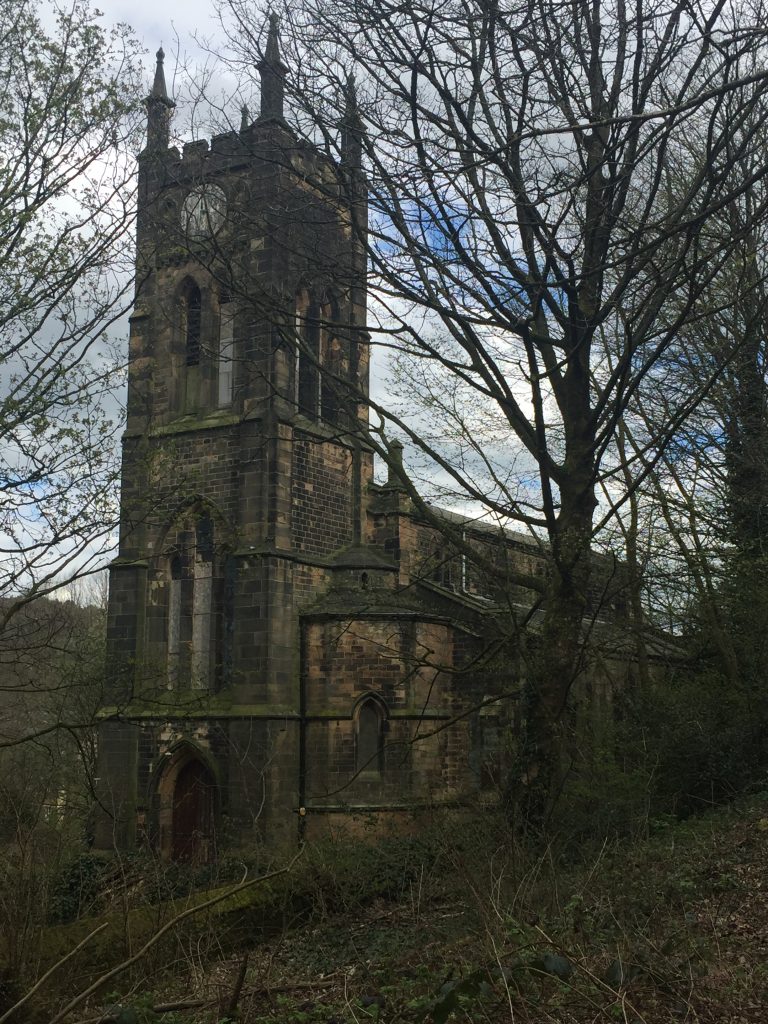
Leave a Reply